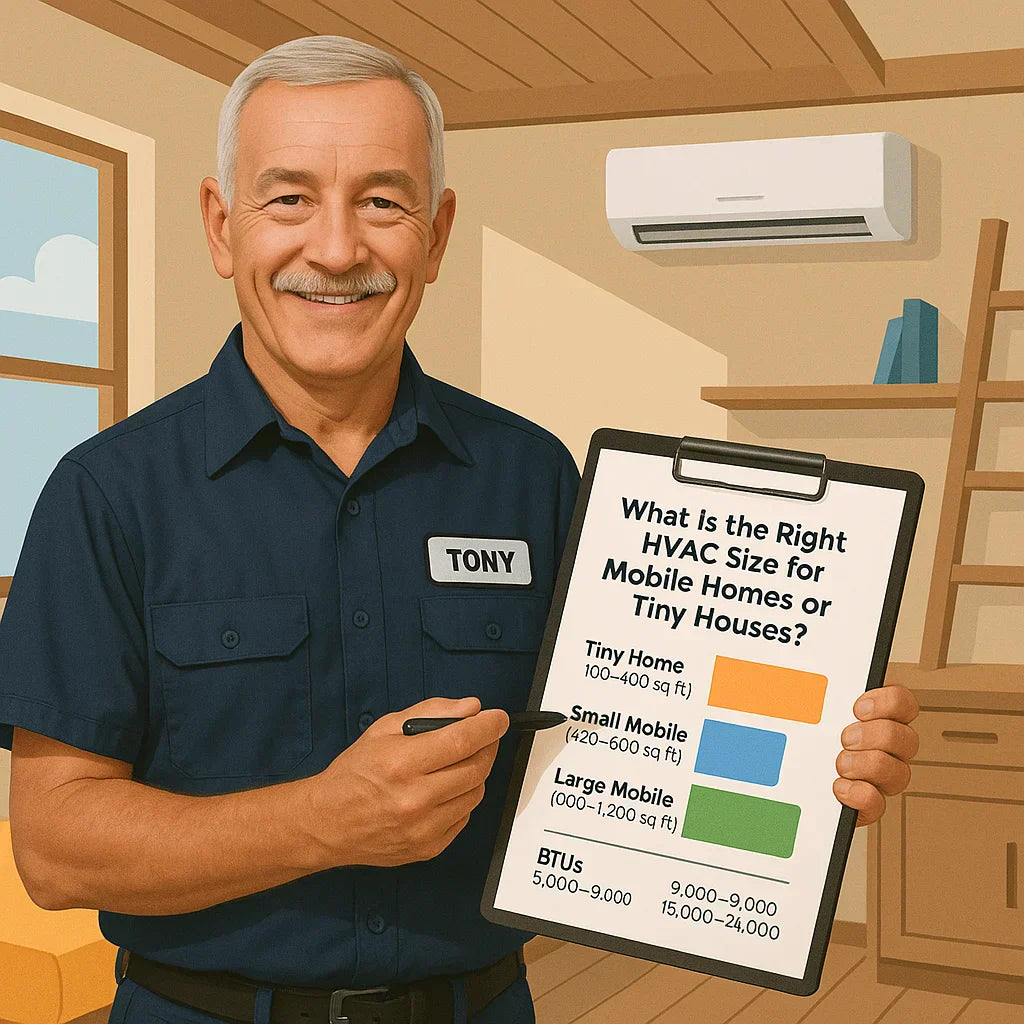Mobile homes and tiny houses come in small packages, but that doesn’t mean HVAC sizing is simple. In fact, when your space is limited, every BTU counts—and oversizing can be just as uncomfortable (and inefficient) as undersizing.
In this guide, we’ll walk through exactly how Tony would approach HVAC sizing for mobile homes and tiny houses—including BTU guidelines, system types, insulation tricks, and pro tips for comfort in small spaces.
🧱 Why Small Homes Require Big Precision
Here’s what makes mobile homes and tiny houses harder to size:
-
Lightweight construction (vinyl, aluminum, foam board)
-
Less insulation (especially under floors and ceilings)
-
High window-to-wall ratios
-
No attics or crawlspaces for duct runs
-
Often built on chassis or trailers (with airflow underneath)
This adds up to greater heat gain/loss, especially in extreme climates. Oversizing leads to short cycling, high humidity, and excess noise. Undersizing leads to discomfort fast.
📏 BTU Guidelines by Home Type
| Home Type | Sq Ft Range | HVAC Capacity (BTUs) |
|---|---|---|
| Tiny House | 100–400 sq ft | 5,000–9,000 BTUs |
| Small Mobile Home | 400–800 sq ft | 9,000–15,000 BTUs |
| Large Mobile/Modular | 800–1,200 sq ft | 15,000–24,000 BTUs |
🔍 Use 20–30 BTUs per square foot, adjusting for:
-
Insulation
-
Windows
-
Climate zone
-
Ceiling height
📊 Visual: Recommended HVAC Sizing for Small Homes

Note: These are general guidelines. Always use a Manual J load calculation for best results.
🧭 Climate Zone Adjustments Matter More in Small Homes
Mobile homes and tiny houses respond quickly to outdoor conditions—so climate zone impacts sizing more than in traditional homes.
| DOE Zone | Region | Strategy |
|---|---|---|
| Zone 1–2 | FL, TX, Gulf Coast | Control humidity + prioritize cooling |
| Zone 3–4 | Southwest, Mid-South | Balance both loads |
| Zone 5–7 | Midwest, Northeast | Heat pumps or high-efficiency gas |
🌀 Best HVAC System Options for Small Homes
| System Type | Best For | Benefits |
|---|---|---|
| Ductless Mini-Split | All mobile/tiny homes | Quiet, zoned, efficient |
| PTAC Unit | Park models, guest houses | All-in-one heat + cool, easy wall install |
| Window/Wall Unit | Tiny homes under 400 sq ft | Budget-friendly, portable |
| Electric Baseboard | Very small or off-grid setups | Low upfront cost, no ducts needed |
| Mobile Home Furnace | HUD-manufactured homes | Properly vented, code-approved heating |
🔗 ENERGY STAR: Ductless System Basics
📐 How to Size Accurately (Tony's Tiny Home Method)
1. Measure Your Conditioned Space
-
Only count heated/cooled interior space
-
Exclude storage lofts or wall cavities
2. Adjust for Volume
-
Tiny houses often have lofted or cathedral ceilings
-
Add 10–20% more BTUs for ceilings >9 feet
3. Evaluate Windows
-
More than 25% window-to-wall = +10% BTU load
-
Single-pane glass = higher gain/loss
4. Factor in Climate Zone
-
Heating load dominates in the north
-
Cooling/humidity dominates in the south
🔌 What About Power Limitations?
Most tiny homes and mobile homes run on 30A or 50A service—so you may need to:
-
Choose low-wattage inverter mini-splits
-
Use DC-powered HVAC systems in off-grid builds
-
Install backup propane or pellet heating
👉 Tony’s Tip: “Always confirm the amp draw of your HVAC system and compare it to your breaker limits.”
📦 Bonus: Portable & Off-Grid HVAC Options
For ultra-light builds or off-grid use:
-
Portable ACs with heat (less efficient but mobile)
-
Propane heaters with CO2 detectors
-
12V or solar-powered DC split systems
Be mindful of ventilation, power availability, and condensation drainage.
🧰 Tools & Resources
📋 Tony’s HVAC Sizing Checklist for Small Homes
| Task | Completed? |
|---|---|
| Measure interior conditioned sq ft ✅ | |
| Check insulation and window specs ✅ | |
| Identify ceiling height and layout ✅ | |
| Determine power limitations (30A/50A) ✅ | |
| Match climate zone to system specs ✅ | |
| Choose ductless, PTAC, or packaged option ✅ |
🧠 Final Takeaway: Sizing Small Means Thinking Smart
In small spaces, efficiency, quiet, and right-sizing matter more than raw power. Tony knows the goal isn’t to flood the space with cold air—it’s to maintain comfort year-round, without noise, humidity problems, or wasted electricity.
So whether it’s a mobile home in Michigan or a tiny home on a Texas lot:
-
Don’t skip the sizing process
-
Avoid overkill BTUs
-
Choose zoned, inverter, or ductless tech when possible
In the next topic we will know more about: Is a 2.5 Ton AC or Heat Pump Enough for Your Home? Room-by-Room Sizing Tips







